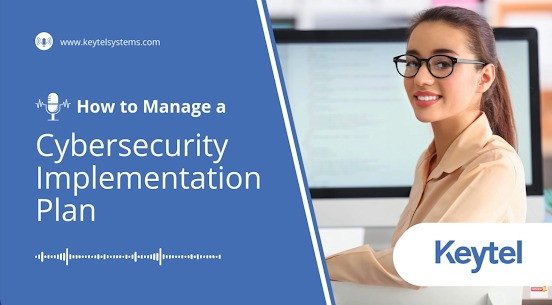IT Company in Orlando Explains How to Implement a Cybersecurity Plan
Building a cybersecurity strategy is needed for any organization of any size. While some basics will remain consistent across all plans, some aspects of your strategy will be unique to your needs. These idiosyncrasies can create challenges when it comes time to roll out your security strategy. For this reason, it’s wise to also establish a cybersecurity implementation plan.
| “Every project at your business needs to come with an established launch plan. This is also true for your cybersecurity policies.” – Kristopher Haley, CEO, Keytel Systems |
Neglecting the roll out plan for your security measures, strategies, and policies puts your adoption rates at risk. If adoption is low, you’ll remain as susceptible to the very cyber threats that you intend to prevent.
This guide from a trusted Orlando IT firm will walk you through how to prevent that challenge. We will explore how to create an IT security implementation plan, tailor it to your needs, and use it to effectively roll out your security controls.
What is a Cybersecurity Implementation Plan?
A cybersecurity implementation plan is the structured roadmap that guides how your organization puts its security strategy into action. While a strategy outlines goals and priorities, the implementation plan defines the steps, responsibilities, and timelines needed to achieve them.
This plan helps bridge the gap between intent and execution. By documenting processes, assigning accountability, and aligning resources, you increase adoption across the business.
How to Create a Cybersecurity Implementation Plan
1.Identify Key Objectives
Start by reviewing the goals in your cybersecurity strategy. Translate those goals into clear objectives that can be tracked and measured. For example, if your strategy highlights stronger access controls, set an objective such as implementing multi-factor authentication across all systems.
2. Assign Roles Clearly
Decide who is responsible for each task in the plan. Assign technical controls to IT staff, training sessions to HR or compliance teams, and oversight duties to leadership. Documenting these assignments avoids confusion and keeps everyone accountable. If staff do not know their part, adoption rates drop, and important tasks may be left incomplete.
3. Establish Realistic Timelines
Set deadlines for every task, from system updates to awareness training. Break large objectives into smaller phases to make progress easier to track. Balance urgency with practicality so tasks can be completed without creating unnecessary strain.
4. Document Steps
Translate high-level policies into specific instructions. Include details such as configuration steps, security training materials, and monitoring procedures. Keep the language clear and actionable so employees at all levels understand what to do.
Detailed documentation reduces errors. It also creates consistency when different teams or locations carry out the same tasks.
Key Elements That Every IT Security Implementation Plan Should Have
| Element | Why It Matters |
| Defined Scope | Outlines the boundaries of the rollout, including which systems, applications, and business units are in scope. This prevents wasted effort and keeps the plan focused. |
| Task Sequencing | Establishes the correct order of steps so that dependent tasks are completed without delays or rework. Sequencing avoids conflicts during rollout. |
| Testing Procedures | Details how each control will be validated after implementation. Testing confirms that actions work as intended before they are considered complete. |
| Escalation Pathways | Provides a clear process for resolving problems if rollout tasks encounter obstacles. Escalation keeps issues from stalling the entire plan. |
| Maintenance Steps | Includes instructions for how to keep new controls operational over time. Maintenance ensures the rollout has a lasting impact beyond the initial launch. |
| Review Schedule | Sets specific intervals to evaluate progress and identify needed adjustments. Regular reviews keep the plan aligned with business needs and evolving threats. |
How to Align Your Cybersecurity Strategy and Implementation Plan
Use Your Strategy as a Baseline For Milestones
Your implementation plan should reference specific points in the strategy as checkpoints. For example, if the strategy highlights identity management as a focus area, the plan should include milestones that verify identity controls are fully deployed.
Coordinate Documentation
Keep the language in both documents consistent. Use the same terminology, control categories, and risk rankings so staff can easily connect what the strategy says with how the plan carries it out.
Align Resource Allocation With Stated Priorities
Resources outlined in the strategy must be scheduled and tracked in the implementation plan. This prevents disconnects where priorities exist on paper but receive inadequate support during execution.
Validate Progress Against Goals
As you complete steps in the implementation plan, check results against the strategy’s expectations. This practice confirms that execution remains tied to the original intent.
Common Roll Out Challenges to Consider While Creating a Cybersecurity Implementation Plan
Low User Adoption
Even the strongest security strategy will fail if employees do not follow it. Users often see new policies as inconvenient, which leads to low adoption. When this happens, your organization stays exposed to the same threats you were trying to stop.
Build training sessions, awareness campaigns, and follow-ups into your implementation plan. Include milestones to confirm adoption rates and identify areas where more communication is needed.
Skill Gaps
You need people with the right skills to correctly implement information security measures. Such skills can be difficult to find. What’s worse is that rapid shifts in technology are widening this gap. Over the course of 2024, the average gap between needed cyber skills and available cyber skills increased by 8%.
Identify areas where specialized knowledge is needed and address any gaps early. Your implementation plan should include either targeted training or support from outside experts to close any gaps as needed. Prioritize security awareness training first, as that will have longer-lasting effects. Regular security training has been found to reduce cybersecurity risks by 71%.
Resource Limitations
Many organizations underestimate the staff time, budget, or tools required to implement their security strategy. When resources fall short, tasks get delayed or corners get cut, both of which can increase cyber risks.
Outline the specific resources tied to each step of your implementation plan. Include contingency measures, such as adjusted timelines or alternative solutions, so that progress can continue if resources run short.
Dependencies
Some security measures rely on other systems, vendors, or processes. If these dependencies are not addressed, rollout can stall or controls may not work as intended. Map dependencies to each step in your plan. Sequence tasks so that prerequisites are completed first.
Change Fatigue
Change fatigue is a pervasive issue that many organizations either ignore or are unaware of. 71% of employees*, including 86% of younger employees*, report feeling overwhelmed by the number of changes their employers are making. 54% of those employees surveyed* report that the level of change fatigue they feel is enough for them to be considering a new job.
Don’t let how you implement your cybersecurity strategy be part of the problem. There are ways that you can implement new changes without tiring out your employees.
Pace your rollout in stages. Introduce major changes gradually and use progress checkpoints so staff can adapt to each stage before moving to the next. Change fatigue is usually caused by too many changes too quickly; the problem improves when changes are spaced out.
Vendor-Related Delays
Organizations often depend on vendors for security tools, software, or services. If those vendors miss deadlines or experience issues, your implementation process could slow down or stop altogether.
Document every vendor dependency in your plan and add buffer time for delivery or setup. Include backup options, such as alternate providers or interim solutions, to keep progress moving if delays occur.
Get Expert Assistance Implementing Your Cybersecurity Plan with a Leading IT Company in Orlando
You know what your business goals are. The challenge is keeping everyone aligned with them as you implement new security measures. If you’re facing this challenge, help is available.
You can ask Keytel Systems for assistance. Our team can also help you create your initial risk management plan before you start thinking about implementation. We can assess your needs and compare them to your biggest risks to help you establish the most effective strategy.
Contact the trusted IT firm in Orlando today to get started on strengthening your cybersecurity plan.




